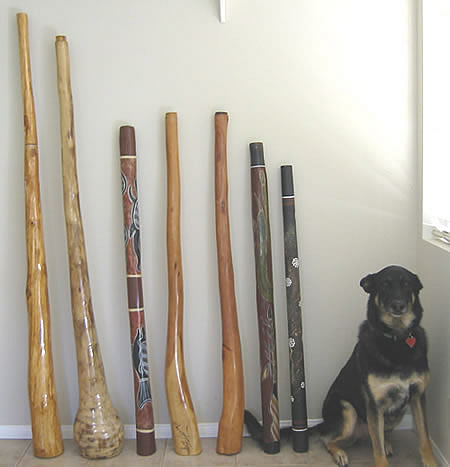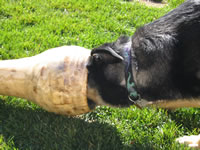|

Left to right:
- Alder wood didge, over 6 feet, made in Oregon by Chad Butler, Key: E
Modified so the top 3rd can be removed and also played
in G
- Arizona desert Agave stalk didge, key: Eb, made by Scott Fischbach
- Eucalyptus didge, shorter than the 1st two, it plays in the low
C
- Eucalyptus didge, Key: F, made by Aboriginal artist David Hudson
- Eucalyptus didge, Key: F, by Nathan Burton, shattering overtones
- Heavy Bloodwood didge, Aboriginal-made, Key of D
- Typical "tourist didge" in the Key of D
- Jasmine the Didgeri-Dog, drones and howls in the Key of C#
As well as traditional termite-hollowed Eucalyptus,
didgeridoos are now also made from other natural and
modern materials. Modern players now integrate the didge
into their own non-Aboriginal "western" styles
of playing, in music ranging from solo playing, to world,
rock, ambient, techno, and every style of music.
|
|
|
Didgeridoo |
|
The Didgeridoo is a long, slightly conical
wooden instrument, used traditionally by the Aboriginal
people of Northern Australia. Other names for the Didgeridoo
are Yirdaki, Kanbi, and Ihambilbilg - although at least
40 different Aboriginal names are commonly used for
this instrument throughout Australia. Known as the oldest
wind instrument in the world, the origins of the didge
may go back as far as 40,000 years. Though only one
"note" can be played with the didge (called
a drone), overtones and vocal sounds from the player
give it a rich sound and countless textures.
Looking to buy a Didgeridoo or find out more detailed information (including playing tips and videos) about this unique and wonderful musical instrument?
Oddmusic recommends visiting:
www.didgeridoostore.com
The Didgeridoo Store is the premiere choice in the USA for the highest quality and widest selection around. Tell them Oddmusic sent you and also see their selection of other unique and fun to play musical instruments !
A technique
called "circular breathing" allows the player
to play the instrument for long periods of time, without
a break in the sound. The technique also yields rhythmic
patterns of the players breath, as well as rhythms that
can be generated purposefully by the diaphragm muscles.
 Click
here to watch a video of Agave Didgeridoo's being
played, along with the Hang drum
Click
here to watch a video of Agave Didgeridoo's being
played, along with the Hang drum |

So this is where that funky sound comes from! |